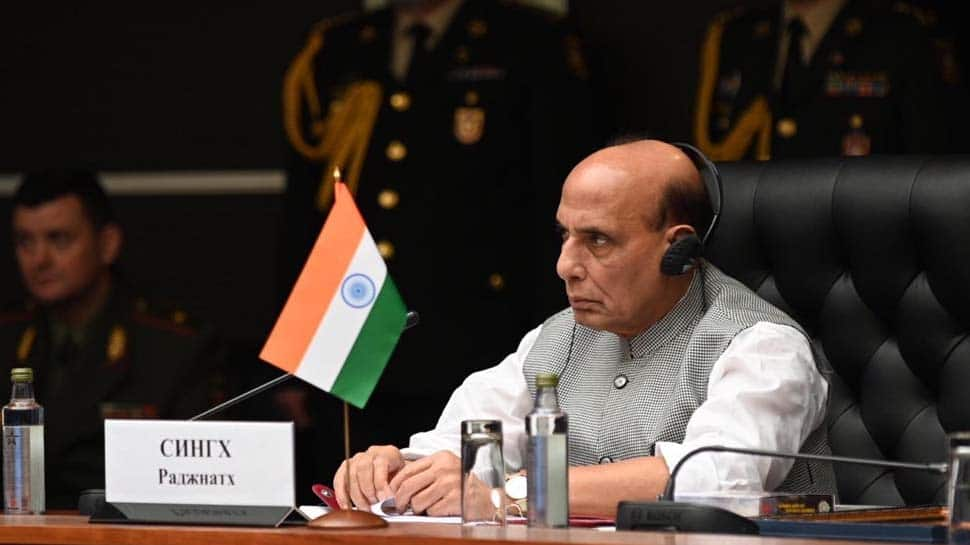Union Defence Minister Rajnath Singh will make a statement in Rajya Sabha on the current situation in eastern Ladakh on Thursday (February 11). Taking to micro-blogging site Twitter, the office of the Defence Minister tweeted on Wednesday, "Raksha Mantri Shri Rajnath Singh will make a statement in Rajya Sabha tomorrow regarding ‘Present Situation in Eastern Ladakh’."
READ | 'Chinese, Indian border troops start disengagement at Pangong lake in eastern Ladakh'
This comes at the backdrop of the Chinese defence ministry claiming that the frontline troops of China and India at the south and north banks of the Pangong Lake in eastern Ladakh started "synchronised and organised" disengagement from Wednesday. It is seen as a forward movement in the overall disengagement process to defuse the over nine-month border standoff.
Raksha Mantri Shri @rajnathsingh will make a statement in Rajya Sabha tomorrow regarding ‘Present Situation in Eastern Ladakh’.
— रक्षा मंत्री कार्यालय/ RMO India (@DefenceMinIndia) February 10, 2021
There was no official comment by either the Indian defence ministry or the Indian Army on the Chinese statement but people familiar with the development said both sides are in the process of pulling back their armoured units like tanks and armoured personnel carriers. The people mentioned above said specific steps like the withdrawal of armoured elements from the friction points were discussed threadbare at the ninth round of high-level military talks on January 24 that lasted for around 16 hours.
Authoritative sources in the Indian defence and military establishment did not refute the Chinese defence ministry's statement on the developments in the northern and southern banks of Pangong lake, an area that witnessed major face-offs since the row erupted on May 5, news agency PTI tweeted.
People familiar with the situation in eastern Ladakh said both sides are in the process of pulling back their armoured units in line with steps agreed upon for overall disengagement in the last round of military talks, adding a clear picture will emerge soon, added PTI. "The Chinese and Indian frontline troops at the southern and northern bank of the Pangong Tso Lake start synchronised and organised disengagement from February 10," a spokesperson for the Chinese Ministry of National Defence Senior Colonel Wu Qian said in a brief statement in Beijing. The statement did not provide details.
"This move is in accordance with the consensus reached by both sides at the 9th round of China-India Corps Commander Level Meeting," it said. Separately, a Chinese foreign ministry spokesman said the frontline troops of the Chinese and Indian militaries began to conduct simultaneous and planned disengagement in the Pangong Lake area on Wednesday as per consensus reached at a meeting of the foreign ministers of the two countries in Moscow in September and the ninth round of Corps commander-level talks.
"We hope the Indian side will work with China to meet each other halfway, strictly implement the consensus reached between the two sides and ensure the smooth implementation of the disengagement process," Wang Wenbin said in a statement. "This move is in accordance with the consensus reached by both sides at the 9th round of China-India Corps Commander Level Meeting," the official added.
A source in the Indian military and defence establishment told PTI there have been some "forward movements" but at the same time added that India will only go by what is happening on the ground. Both sides rushed a large number of battle tanks, armoured vehicles and heavy equipment to the treacherous and high-altitude areas of the region after tension escalated following a deadly clash in the Galwan Valley in June last.
Twenty Indian soldiers were killed in the fierce hand-to-hand combat on June 15 in Galwan Valley, an incident that marked the most serious military conflicts between the two sides in decades. China is yet to disclose the number of its soldiers killed and injured in the clash though it officially admitted to have suffered casualties. According to an American intelligence report, the number of casualties on the Chinese side was 35.
At their ninth round of military talks, the Indian and Chinese armies agreed to push for an "early disengagement" of troops and resolved to continue "effective efforts" to stabilise and control the situation in eastern Ladakh. "The two sides agreed to continue their effective efforts in ensuring the restraint of the frontline troops, stabilise and control the situation along the Line of Actual Control in the Western Sector of the China-India border, and jointly maintain peace and tranquillity," said a joint statement after the talks.
India has all along been maintaining that the disengagement process has to start simultaneously at all friction points and no selective approach was acceptable to it. India was specifically insisting on the withdrawal of the troops of the Chinese People's Liberation Army(PLA) from Finger 4 to Finger 8 on the north bank of Pangong Lake. The mountain spurs in the area are referred to as Fingers.
Close to 100,000 Indian and Chinese troops are deployed in eastern Ladakh amid continuing diplomatic and military talks to find an amicable solution to the standoff.
















